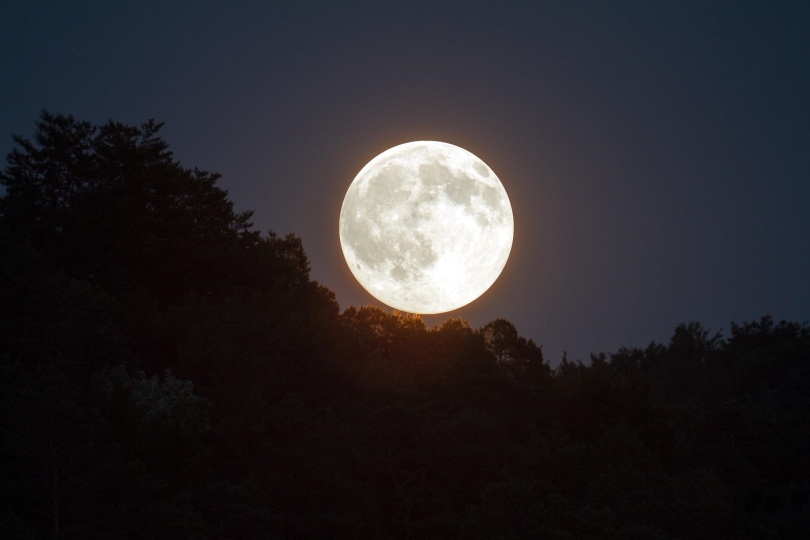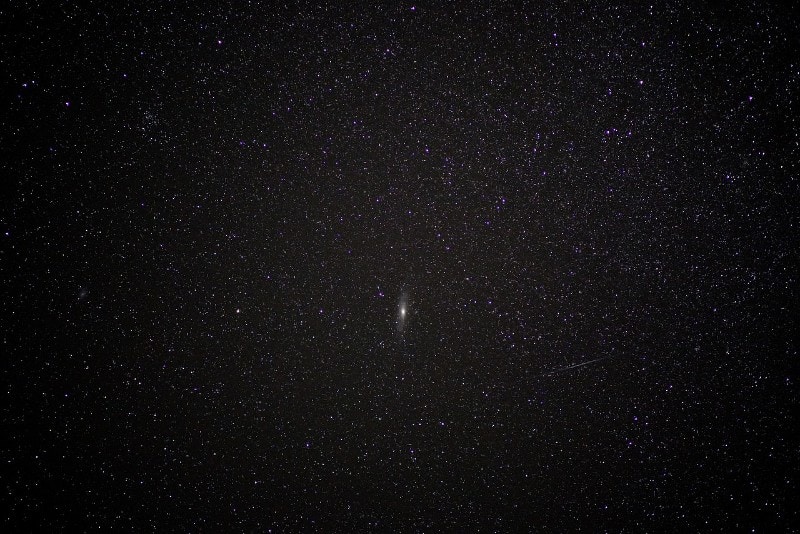Is the Moon a Star? The Interesting Answer!
Last Updated on

No, the moon is not a star. But we can see how you’d think it’s a star, considering stars are celestial bodies just like the moon. What makes the moon different from a star is its inability to produce its own light.
We’re almost certain that you’ve heard stars are astronomical bodies mostly made up of helium and hydrogen. Those are the two gasses that are responsible for the light we see, and the heat felt. In the case of the moon, the only elements that are present are oxygen, chromium, manganese, iron, silicon, aluminum, magnesium, titanium, and calcium.
That’s just a brief rundown of what distinguishes the moon from a star. But if you’d like to learn more about these celestial objects, keep on reading.

What Is a Moon?
We’ve made some tremendous discoveries since the invention of the telescope. Those who lived during the Middle Ages only knew the moon as a large, round, mystical object that manifested the power of the gods. But thanks to this optical instrument, we learned that this beautiful mystic object wasn’t exactly unique to earthlings. There were other moons all orbiting other planets.
A moon is any celestial object that follows a roundish path (orbital) around a planet—the term “planet” in this context, represents all planets known to man, including the minor, dwarf, and eight chief planets.

Who Discovered Other Moons?
Galileo Galilei was the first person to discover other moons. When he pointed his homemade telescope at Jupiter, he saw what appeared to be a group of stars. It was not until they started moving “in the wrong direction” that he realized they were actual moons orbiting the largest planet in the solar system.
The “stars” consisted of Calisto, Ganymede, Europa, and Lo. They are now known as the Galilean moons of Jupiter because they were discovered by the Italian astronomer. We went on to discover 59 other moons orbiting that planet, and several others in our solar system.
Besides the Galilean satellites, we have two other moons that are relatively similar in size to our planet’s moon. That is the Triton and Titan, which orbit Neptune and Saturn, respectively.
It’s important to note that some of the moons mentioned above are geologically active. That means, they have already shown signs of tectonic activity, and some have even been caught spewing lava. The Triton, Titan, Europa, and Io, have all been proven to be volcanically active.
Have they always been volcanic? We think so, as our instruments have helped us determine that some of them have maintained the same level of volcanic activity for billions of years. Since we didn’t have the technology to study them before that period, we’ll just assume they’ve always been that way.
How Many Moons Are in Our Solar System?
At the moment, we’re not completely sure how many moons are out there. But what we can confirm is that there are more than 300. That includes the 168 orbiting our solar system’s planets, Trans-Neptunian objects, asteroid moons, and those orbiting dwarf planets.
From the look of things, it’s going to be more and more difficult to define what constitutes a moon, as their traits keep on changing. For instance, if a moon is a natural satellite that orbits a planet, and it reflects the light received from a star, is it fair to call a celestial shiny rock orbiting a planet a moon?
If the answer is yes, then we have millions of moons in space, some yet to be discovered. And if the answer is no, why? What makes it so different from a moon, which is also a celestial body made of rocks? Could it be the size? Because the last time we checked, our astronomers are not even on the same page as to what should be the standard size of a moon.
The question “What is a moon?” is sort of ambiguous. There will always be more than one interpretation, none of which is satisfactory.

What Is a Star?
As babies, they used to tell us that the stars twinkle. And that’s true, only if you’re within the confines of our planet’s atmosphere. If you somehow find a way to move past those boundaries, and into space, you’ll quickly realize that they don’t actually twinkle but emit hot gasses.
These stars that we get to see from a distance are nothing more than celestial objects primarily made of helium and hydrogen. Their interactions and reactions at the core are the sources of the heat that we often feel and the light we see. In terms of relative distance, the sun is the closest star to Earth. All the others look like dots in the sky at night because they are millions of light years away.
Again, we cannot give you a definitive number when we’re talking about the total number of stars, but our brilliant scientists have estimated that we have close to 200 billion stars taking residence in our Milky Way galaxy alone.

What Are the Origins of These Stars?
Stars don’t come into existence the same way moons and planets do. Their birth is a lot more fascinating.
Stars are born within the “Nebulae.” This is the term used to describe dust clouds found in space that are purely made of hydrogen. The process is gradual, as it normally takes thousands of years. Due to gravity, the small pockets of dense matter found within this cloud slowly start to crumble under their own weight, ultimately creating what we call the “Protostar.”
This stage has always been dubbed the star’s nascent phase, otherwise known as the budding phase. And if you’re wondering how all this goes on undetected, it’s because dust clouds make it virtually impossible for our pieces of equipment to see anything. Even if you know what you’re looking for, all you’ll see is dust. The reactions within are completely obscured.
At this point, the protostar is essentially a mass of contracting gasses. And as it gets smaller due to the gravitational pull, it starts to spin faster to conserve angular momentum. Eventually, the pressure increases, consequently leading to an increase in temperature. Thus, signaling the start of a different stage, known as the T Tauri phase.
That phase will last for close to 100 million years, as the star works to get its core temperature to 15 million degrees Celsius. Once it gets there, the process of nuclear fusion will automatically kick off. This will in turn ignite the core, and get it to its final stage, the Main Sequence.
The sun is a good example of a main sequence star. And so are most of the other stars found within our galaxy. We’ve studied many of them and concluded that they are currently in a stable state of nuclear fusion. Continuously transforming hydrogen to helium is obviously no small feat, as it’s the reason why the stars are constantly releasing colossal amounts of energy.
Are All Stars the Same?
No, like humans, stars are born different. Some are shinier than others because they have the ability to convert more hydrogen to helium and radiate more x-rays. We’ve also established that their colors are all different, as they have varying temperatures. Those that are extremely hot have blue and white hues, while those that are comparatively cooler come in red or orange hues.
We’ve been able to use these different variables to classify stars in various groups. If you check out the Hertzsprung-Russell diagram, you’ll get a good idea of what we’re talking about. Some stars fall under the main sequence category, those regarded as white dwarf stars, super-giants, giants, etc. For the sake of context, a supergiant star has a radius that’s wider than that of our sun—they say it could be a thousand times larger.

Final Thoughts
We once thought that the moon was a cold and dead rock, orbiting our planet. But recent discoveries have made us believe there was once some level of volcanic activity at its core and on the surface. We just didn’t know it then because those eruptions happened millions of years ago. Unfortunately, even though we still speculate that future eruptions are possible, they won’t happen within our lifetime.
Featured Image Credit: zoff, Shutterstock
About the Author Robert Sparks
Robert’s obsession with all things optical started early in life, when his optician father would bring home prototypes for Robert to play with. Nowadays, Robert is dedicated to helping others find the right optics for their needs. His hobbies include astronomy, astrophysics, and model building. Originally from Newark, NJ, he resides in Santa Fe, New Mexico, where the nighttime skies are filled with glittering stars.
Related Articles:
What Is the Best Binocular Magnification for Hunting? Optical Features Explained
15 Crucial Facts About Ultraviolet Rays & the Sun
What Constellation Is Spica In? The Interesting Answer!
10 Interesting Leo Constellation Facts, Myths, and FAQs
15 Interesting Pegasus Constellation Facts, Myths, and FAQs
6 Interesting Sagittarius Constellation Facts, Myths, and FAQs in 2024!
What Are Constellations? Where Did They Come From?
8 Interesting Libra Constellation Facts, Myths, and FAQs
